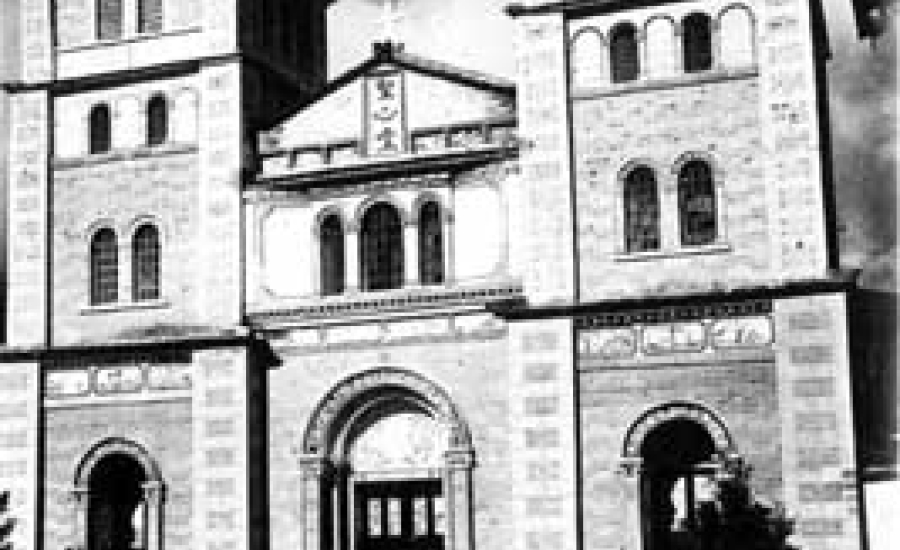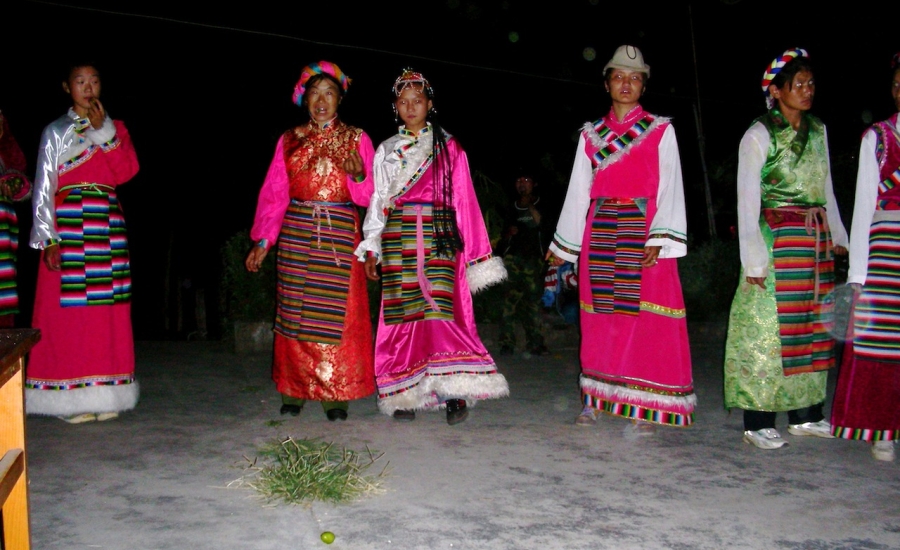TCHRONGTEU – BINGZHONGLUO
A highway stretches in the direction of the upper reaches of the Nu River; it now winds at the foot ‘of Biluo Mountain with its top perennially snow-clad— to the east of the river; it then runs before Gaoligong Mountain tothe west of the river. The two mountains run from north to south in parallel and relcntlessly sandwich the violent and recalcitrant Nu River between them. The vertical elevations of the mountain peaks along the banks of the river range from 3,000 to 4,00o metres. It is a marvelous grand canyon-like landscape. The river mars and rushes at the speed of three or four metres per second. I was rather tempted to think the river was straining to tear away from the restreint the two mountains imposed upon it.Spanning the river arc not only ancient table bridges but also modern suspension table bridges. This odd juxtaposition of the old and the new civilization may be symbolic of the cultural transition the nationalities living in the Nu River region are now experiencing.
Bingzhongluo area can be reached travelling on foot northwards from Gongshan County in two days. Two flat « tocs » of Biluo Mountain protrude unexpectedly from under its precipice at some distance to the south of the Bingzhongluo area. Here the Nu River has to bypass the « tocs » and thus describes a big semi-circle looking roughly like a U. The stream flowing in this U-shaped bend is rather placid. 1 saw some Nu people fishing in the bend in their canoes. A beautiful tableland stands to the north of the river bend. Further north looms the perennially snow-covered Peak of Gaoligong Mountain. The slope of the mountain is a bizarre mosaic of variform paddy fields in which the people have recently harvested their paddy crops. Interspersed among the paddy fields are houses with glistening white walls and roof-tops covered with stone slabs. The area these housesi,are in is called Bingzhongluo which has over 5 o villages under its tare and is populated by more than 8,000 people. The majority of the population are the Nu people, who have ail along managed to preserve their own customs and way of living. They keep to themselves and lead a calm and simple life.

The agriculture of the Nu nationality is more advanced than that of the Drung people; the system of private ownership of arable land is basically regulated in the Nu community. The Nu people lay great emphasis on fertilizing their land. An average household in a Nu village can raire as many as three or four oxen as draft animais. The Nu people generally yoke two oxen to a plough, which is rigged up to a thick wooden bar; the traces of the two farm cattle are fixed to both ends of the wooden bar. So the local people call this way of yoking « two-oxen-carry-a-bar. » The staple products here include wheat, corn, buck wheat, and highland barley. Some parts of Bingzhongluo, which have a mild climate, grow paddy crops.
By mid-November, the Nu people in thc Nu River Valley are involvecl in their busiest season of a year which is devoted to working on autumn harvest and sowing. The villagers àre zealously developing co-operation in farm work. In the busiest season, a villager may ask any other villager to help with his reaping and sowing. The helpers are entertained to handsome dinner but never ask for any other reward. Jia Mucheng, in whose house I took up my temporary lodging when I was touring the Nu people’s area, asked six villagers to sow the seeds of highland barley for him in his plot. To sow the seeds over the soil of a plot of land is the first and primary step in the whole process of sowing; a good harvest presupposes a dexterous and timely sowing of the seeds. Therefore, the Nu people are ail very careful in timing the operation of seed-sowing.

Early in the morning of the day set for SC ed-sowing, Jia Mucheng laid a table laden w ith offerings in front of the fireplace. The th ings Jia piously set forth on the table include the grains of five terrai plants, a bunch of fl )avers, a bunch of pine needles, and a lamp fueled with butter. He kindled the lamp as soon as he had laid the table. To entertain the six helpers, he prepared buttered tea, mild wine, roasted baba, stewed taro, and other food. It 1S the convention of the Nu people that a pig or p gs must be killed on the day of seed-sowing. But the pig to be sacrificed on that day should he a suckling weighing no more than Io kilogrammes. Great fat hogs arc preserved for the entertainment in the Spring Festival. The helpers ate breakfast at their own homes, shouldered the ploughs and led their oxen to
a’s home and from there Jia and his helpers set out to his field. Thev sowed the highland barley seeds over the soil and turned up the soil with ploughs drawn by oxen. Though these helpers came to join the job for friendship sake they worked most strenuously. Their sonorous commands to the oxen mingling with their light-hearted laughing and talking rang merrily over Jia’s field.

In the gathering dusk, they came back to Jia’s home and had a dinner together around the fireplace. The dinner was sumptuous, and thev ate it in a most cordial atmosphere as if they were really of one family. Gudu wine (a mild alcoholic drink brewed of corn) and edujan (cooked corn grain, which is unhusked and finely pestled) are two favourites indispensable to such feasts. Jia put the sweet and sticky edufan in a bamboo crate. The guests would help themselves to the gudufan. They used chopsticks — – measuring about 4o centimetres long – to dig up a lump of gudufan from the crate. Then committing the lump of gudufan to his loft hand, he nibbled at it, while with his right hand wielding the chopsticks he plyed himself with titbits from the dishes on the table. To show his gratitude to his helpers Jia served them delicacies like stewed pig’s trotters and taro, stewed sucklings, soup of bean curd and pig blond, crisp and sweet roasted baba. Baba is generally made of buckwheat flour. There are two species of buckwheat: the sweet buckwheat and the bitter buckwheat. The Nu people do not use a frying-pan for roasting baba. Instead, they use a kind of frying slab they quarry in the depth of a mountain. They first heat the slab on a tripud over the fireplace; then they spread the watery dough of buckwheat flour over the heated slab. When one sicle of the spread dough is done, the dough is turned over for roasting the other side. A multi-layer baba can be roasted by spreading more than one layer of dough One after another. This kind of slab bas the property of transmitting heat evenly to all its parts, and it never cracks under the action of heat. It is counted as one of the indispensable cooking facilities of the Nu people.
Though I did not go to help with seed¬sowing in Jia’s field, still as a guest coming from afar. 1 was invited to the dinner Jia gave in honour of his six helpers Thus I was given the pleasure of enjoying the mirth bred of their esprit de corps. The host, warmhearted and hospitable, while earnestly helping his guests to all the dishes, sang laudatory songs to express his thanks to all the helpers as well as his delight in having me as a lodger in his house. The host and his guests became more excited after the first round of toasts; people began to sing white helping each other to the dishes and became more at home and intimàte as if thcy were all of one family. After the dinner they began to dance, circling about the central pillar in the chamber until Tate into the night when their mothers or vives came to Jia’s to summon them home. The institution of cooperation in farm work can be traced far back to the primitive practice of mutual assistance. This practice had been followed generation after generation and has evolved into the present social hehaviour of cooperation in faim work. It is a manifestation of the traditional virtue common to the Nu people.
EXTRAIT tiré du livre intitulé « LIFE AMONG MINORITIES NATIONALITIES OF NORTHWEST YUNNAN » des auteurs Shen Che et Lu Xiaoya – éditeur Liao Pin – first Edition – 1989
dmc


















